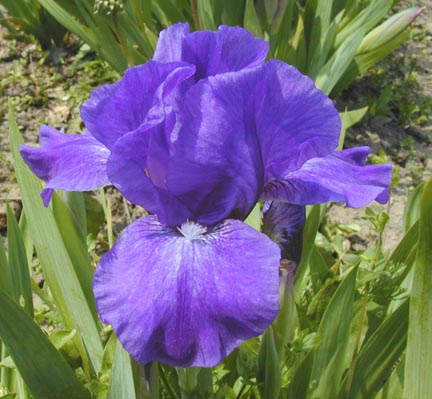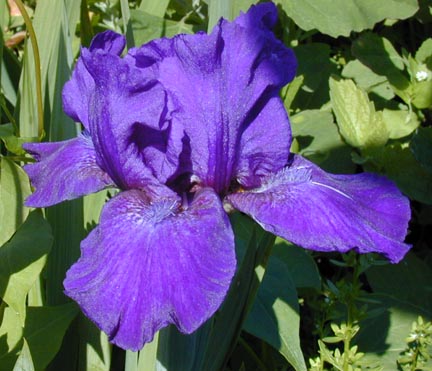This is a public-interest archive. Personal data is pseudonymized and retained under
GDPR Article 89.
RE: Blue Plicatas
- Subject: [PHOTO] [iris-photos] RE: Blue Plicatas
- From: i*@netscape.net
- Date: Mon, 24 Jan 2005 22:27:24 -0500
The two seedlings attached are blue plicatas from a cross of Chubby Cheeks X
Lilac Lulu ( a luminata) .The other seedlings were plicatas (of Chubby Cheeks
type), glaciatas , luminatas ( a variance on pattern and some looked more
like zonals) and these blue types. I don’t recall there being any plicata
-luminatas . The count was small but these four types were fairly evenly
distributed.
The SDB are amphidiploids having two sets of 8 genes from the tetraploid Iris
pumilla and two sets of 12 from the tetraploid tall bearded iris. These
always separate as 8/12 in the gametes, hence the term amphidiploids. The
pumilla set of 8 chromosomes have the pla allele (glaciata) and only this
allele. Thus all SDB plicatas have two pla genes and two others from the set
of pla (glaciata), pl (regular plicata) and plu.(luminata) This gives a total
of 6 genotypes for the SDB. An SDB plicata cross acts like a diploid for the
plicata genes. I keep hoping that at some point one of the other plicata
alleles will cross over to the pumila set of 8 genes. This will be obvious as
we will then be getting more of the TB plicata genotypes and the SDB plicata
crosses will start acting like a tetraploid rather then a diploid cross. So
far no luck. It may just be impossible given the differences in genes between
the set of 8 and set of 12..
Chubby Cheeks can be shown to be pla pla pla pl based on its offspring. Lilac
Lulu being a luminata has pla pla pla plu. This gives four different
plicata genotype offspring which is what was seen in this cross. The glaciata
seedlings certainly confirms these genotypes. These blue seedlings should be
pla pla pl plu genotype. Normally I would expect these to be
luminatas-plicata.
If this was the only example of this we could assume some sort of error.
They have shown up in several other places. Dr. Randolph presented what I
have been calling the “Randolph Puzzleâ€on page 353 in his book “Garden
Irisâ€This puzzle included three generation of breeding with plicatas. The
puzzle was how to interpret the results as he had blue flowers from a plicata
cross. When he tested crossed one of these blues that he thought should be a
plicata with Matterhorn ) a white glaciata) he got results showing that this
blue seedling ( actually described as blue with white splotched hafts ) acted
as a plicata except that some seedlings were blue. The numbers from this
cross were 57 seedlings, 6 blue selfs, 22 luminatas , 18 plicata ( Los
Angeles pattern ) and 10 whites. This fits with the blue seedling being a pla
pla pl plu genotype as are the two seedlings I have included a photo of, and
with the blue seedlings being this same genotype. In this case we are using a
tetraploid punnett square. These numbers are a remarkably good fit for the
data. I have not found any other fit for this data and I have tried many many
different fits over at least four years. Feel free to try.
These same blue plicata genotypes show up from at least one plicata x plicata
cross made by the Sass brothers as documented in a letter from Sass to Dr,
Randolph. This letter is in the AIS archives library.
Willma Vallette in her book “Iris Culture and Hybridizing fo
Everyoneâ€documents on pg 326 five different solid coloured cultivars
giving 100 percent plicata in a cross with a plicata . These cultivars are
Great Lakes, Great Day (orange-red self) , Privateer (deep cardinal red)
Shannopin, ( a red/white bicolour) and Red Orchid (dark red IB) . Great
Lakes fits in colour with the other blue plicatas discussed here.. In
addition, Great Lakes in a cross with a pumila seems to have produced a white
glaciata (suggestive from its offspring but not conclusive) and very well
could be the pla pla pl plu genotype.
The best explanation that I have been able to formulate for this is in
reference to species of origin. Iris pallida has been strongly documented
(Dykes) as being one of the species that the plicata allele has originated
from. Pallida are light blue/lavender. There are no plicata pallida found in
the wild. Thus the plicata gene is probably epistatic ( has one effect in
this species but a different effect when combined with another set of genes
from another species). The anthocyanin colour in pallida is a lighter tone,
more lavender then the anthocyanin seen in other iris species. It is still a
form of delphinium but has different sugar and hydroxyl attachments etc. My
speculation is that these blue plicatas have enough of this pallida blue to
effect the expression of this genotype.
This is where the posting by Linda of her pallida seedling becomes relevance
to the analysis of the MV seedlings.
The other solid coloured plicata cultivars that Vallette documents are much
darker. I suspect a similar interaction of plicata with the AE (anthocyanin
enhancement) gene (if such should prove to exist). That is one or more
plicata genotypes with AE (two or more doses) no longer resemble the classic
plicata phenotypes.
90-190-4 crossed to a plicata is one parent of Eramosa Enigma .This is a
washed blue on a lavender-blue ground. Not at all a typical plicata pattern ,
yet a plicata non the less.
Chuck Chapman
__________________________________________________________________
Switch to Netscape Internet Service.
As low as $9.95 a month -- Sign up today at http://isp.netscape.com/register
Netscape. Just the Net You Need.
New! Netscape Toolbar for Internet Explorer
Search from anywhere on the Web and block those annoying pop-ups.
Download now at http://channels.netscape.com/ns/search/install.jsp
------------------------ Yahoo! Groups Sponsor --------------------~-->
In low income neighborhoods, 84% do not own computers.
At Network for Good, help bridge the Digital Divide!
http://us.click.yahoo.com/EA3HyD/3MnJAA/79vVAA/2gGylB/TM
--------------------------------------------------------------------~->
Yahoo! Groups Links
<*> To visit your group on the web, go to:
http://groups.yahoo.com/group/iris-photos/
<*> To unsubscribe from this group, send an email to:
iris-photos-unsubscribe@yahoogroups.com
<*> Your use of Yahoo! Groups is subject to:
http://docs.yahoo.com/info/terms/


Other Mailing lists |
Author Index |
Date Index |
Subject Index |
Thread Index



